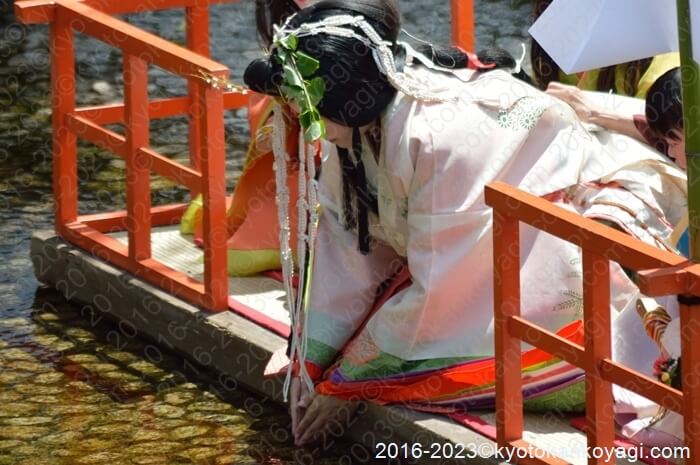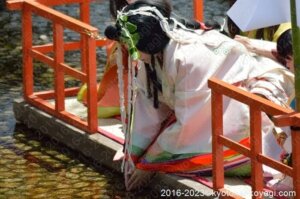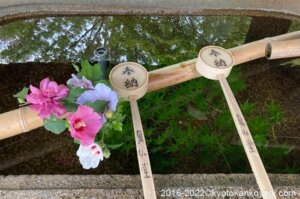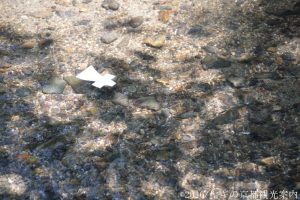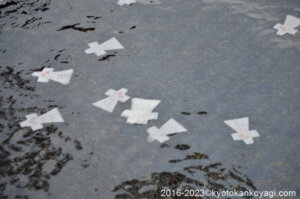Introduction
Misogi and Harae is the ways to get rid of evilness in order to prepare for something sacred. They are the deeds familiar to us and you’ll see them when you visit Shito shrine, Buddhist temples, ceremonies, events and so on. In this post, I’ll show you what they are. 合掌
Misogi 禊
Kegare (穢) is an anemic state of mind. Misogi (禊) is to bathe oneself in river or ocean to get rid of it. Misogi is based on a story in Japanese mythology.
Izanagi no Mikoto (伊邪那岐命) and Izanami no Mikoto (伊耶那美命) are parents/creators of the country and many Kami (deities). When Izanami gave birth to Kagutsuchi, the kami of fire, she got burned and passed away. Izanagi missed her so much that he went to Yomi no Kuni, the place for the deceased, to see his wife.
He asked her to go back to the world once her belonged. She said that she would ask Yomotsukami, the ruler of Yomi no Kuni, whether it was possible. And she asked Izanagi, “Don’t take a look at my body while I’m away.”
He broke the promise and found her corpse. She was so embarrassed and angry that she chased him around. He escaped from Yomi no Kuni narrowly and found himself in Kegare because he saw the extreme case of an anemic state of mind: Dead body.

We think anemic mind could take our lives in the worst case. He thought he saw the worst case of Kegare.
Kojiki put it: 是以伊邪那岐大神詔、吾者到於伊那志許米、志許米岐、穢國而在祁理。故吾者爲御身之禊而、到坐竺紫日向之橘小門之阿波岐、原而、禊祓也。
After that, Izanagi bathed himself in a pond to get rid of the Kegare he had in Yomi no Kuni.

Traditionally, we believe in water which has a power to make anything reborn and come alive. In the last sentence, we find 祓. The 祓 is not the one in next chapter. It is means the same as Misogi.
Harae 祓
Harae is the way to get rid of Tsumi(罪). Tsumi is a thing to ruin our life.

Tsumi is usually translated as “crime” or something but it’s not the one we are talking about.
As Kegare, Harae also is based on a story in Japanese mythology:
Suasnoh no Mikoto made Tsumi to violate the order of Takamagahara where Amatsukami deities were. Due to his Tsumi, Amaterasu Ohmikami, the deity of the sun, hid away to a cave and the world went into a complete darkness. Other deities managed to pulled her out of the cave and the sun rose again. After the incident, they ousted Susanoh out of Takamagahara.
Kojiki put it: 於是八百萬神共議而、於速須佐之男命負千位置戸、亦切鬚及手足爪令祓而、
In a nutshell, the sentence says that they asked him to hand in things to make up for his Tsumi. And they also cut his nails and beard off.

Ancient people thought they put their Tsumi into a part of their body they can remove. And they using it as a tool of getting rid of their Tsumi.

Today, Tsumi means the deeds to violate the social norms and our inadequate or un acceptable attitude.

But we cannot tell Tsumi from Kegare exactly today. As described later, we get rid of Tsumi and Kegare in Nagoshi no Harae.
Saiohdai Gyokei no Gi and what we do 斎王代御禊の儀と我々の行為
Saiohdai Gyokei no Gi is a ceremony held prior to Aoi Matsuri. Saioh dai is a lady plays a role of Saioh.

Saioh is a priestess served for Kamosha (Kamigamo shrine and Shimogamo shrine) on behalf of an emperor when Aoi Matsuri was held. Saioh was under Kessai (潔斎) for years preparing for Aoi Matsuri.

Kessai is a way to get rid of evilness to be in a state to see something/ someone sacred. IDEST, She exercised Misogi and Harae. As described in The Tale of Genji, Saioh practiced Misogi at the bank of the Kamo river in old days.
Today, Saiohdai carries out Misogi and Harae in the ceremony.
Example of Misogi 禊
Misogi Saiohdai does
The Misogi in Saiohdai Gyokei no Gi is an abbreviated one: She just touches the stream.

Saiohdai Gyokei no Gi is an event. It isn’t a ceremony or ritual and she isn’t a priestess. But the Misogi works though the one she did isn’t an authentic one. Actually, as we discuss later, we practice an abbreviated Misogi before we enter Shinto shrines and Buddhist temples.

Saiohdai do Misogi in order to get ready for the sacred festival.
Misogi we do
When we enter a Shinto shrine or a Buddhist temple, we usually find a basin like this. We did an abbreviated Misogi there.
- Take a dipper in your right hand and pour the water over your left hand.
- Take the dipper in your left hand and pour the water over your right hand.
- Take the dipper in your right hand again
- Pour the water in your left hand (Use the left hand as a bowl).
- Rinse your mouth with the water hiding your mouth with your left hand.
- Raise the dipper to let the water run the handle of it.

We do Misogi in order to get ready for entering the sacred places.
Example of Harae 祓
Harae Saiohdai does
Harae of Saiohdai is an abbreviated one like Misogi. She uses a Hitogata as Katashiro.
Hitogata is a human-shaped piece of paper. Katashiro is a substitute for us.
Saiohda uses it as a substitute for nails and beard: She rubs herself with a Hitogata and breath out over it in order to put her Tsumi in to it.

Saiohdai do Harae in order to get ready for the sacred festival.
Harae we do
On the last day of June, many Shinto shrines and Buddhist temple hold Nagoshi no Harae thorough the archepleago. It is a ceremony to get rid of Tsumi and Kegare. And some of them also hold Oharae on the last day of November. We use Hitogata as Saiohdai does.

As I said, we cannot tell Tsumi from Kegare exactly. We think we gain both of them in daily life and get rid of them in Nagosho no Harae and Oharae.
In both ceremonies, we use Hitogata as Saiohdai for the same purpose.
In addition to it, in Nagoshi no Harae, we usually do Chinowa Kuguri to keep epidemics away from us.


Summery
Misogi is the way to remove Kegare, the anemic state of mind and Hare is the way to remove Tsumi, the deeds to violate the social norms and our inadequate or un acceptable attitude. Both of them have its roots on Janapese mythology and we exercise them in abbreviated ways today.

